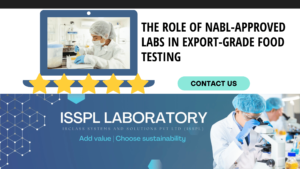An Overview by Team ISSPL - Analytical Testing Laboratory in India
ToggleIndia stands tall as one of the world’s largest peanut producers and exporters. From the sun-drenched fields of Gujarat and Rajasthan to ports shipping to Europe, the Middle East, and Southeast Asia, the journey of a peanut is more complex than it seems. Behind every successful export is an invisible layer of rigorous testing that ensures safety, quality, and compliance.
But what does peanut testing really involve? What makes a laboratory “IOPEPC-approved”? And why is this approval so essential for exporters today? Let’s peel back the layers and demystify this vital aspect of the peanut supply chain.
The Importance of Testing in Peanut Exports
Quality control in agriculture involves more than how things look. Ensuring safety is especially important for peanuts that will be sold overseas. The presence of aflatoxins, pesticides and harmful microbes can make food unsafe, cause rejected shipments, lead to financial losses and harm a company’s reputation.
The only thing protecting exporters from these risks is peanut testing. It guarantees that all peanuts are safe for people in India and abroad and that each batch is suitable for use and trading.
Since many countries, such as those in the European Union, have strict food safety regulations, food companies must ensure their laboratories are highly precise.
What is the IOPEPC and What Makes It Important?
The Indian Oilseeds and Produce Export Promotion Council (IOPEPC) was established by the Ministry of Commerce and Industry. It is responsible for growing and promoting exports of oilseeds, with peanuts being one of the main products.
IOPEPC is responsible for controlling and confirming the export of peanuts. Laboratories that wish to obtain IOPEPC approval must ensure their facilities, equipment, accuracy and compliance are up to standard. Only COEs based on results from certified labs are recognized for exporting peanuts from India.
So, any peanut being exported must be tested in a lab that is approved by the IOPEPC. If a business does not follow the rules, their shipments may be refused, they could face customs problems, pay penalties and be denied entry to other nations.
What Does an IOPEPC-Approved Lab Do During the Testing of Peanuts?
Before peanuts are sold to buyers or consumers, they go through several tests. This is a summary of what occurs behind the scenes:
- Sample Collection
Professionals use standard IOPEPC protocols to collect samples from large consignments. As a result, all units have an equal chance of being included in the sample.
- Physical Examination
The samples are examined for any physical issues. The size, shape, color, moisture and soil damage rate are all evaluated. As a result, products are usually sorted into different markets and given their appropriate price ranges. - Aflatoxin Analysis
This is likely the most important aspect of ensuring peanut safety. Certain molds create aflatoxins, especially under poor storage conditions. To ensure aflatoxin levels are under the allowed amount, labs at ISSPL use HPLC or ELISA kits to measure them. - Pesticide Residue Analysis
Residues from farming may remain in peanuts. Exporters must confirm that the MRL (Maximum Residue Limit) is not exceeded. Using GC-MS/MS and LC-MS/MS, these residues can be detected in trace amounts to comply with international standards. - Microbiological Testing
Peanuts may contain bacteria such as Salmonella, which can cause serious foodborne illness. In a microbiological lab, harmful organisms are detected and quantified using culture methods or Real-Time PCR. - Reporting and Certification
After completing the tests, the lab provides a detailed report. If the laboratory meets IOPEPC’s standards, it sends the results, and the shipment cannot leave the country without the Certificate of Export.

How Does an IOPEPC-Approved Lab Differ from Others?
Some labs are better than others. Laboratories certified by IOPEPC are required to follow strict rules and guidelines. This is what makes them different:
- Being ISO 17025 Accredited (NABL) means the laboratory is technically skilled and accurate in its calibration.
- APEDA and FSSAI registration ensures labs follow national food safety standards.
- Domain-trained analysts and microbiologists are employed in the field.
- The main tools for quality analysis are LC-MS/MS, GC-MS, HPLC, FT-IR and ICP-MS.
- Test records are maintained securely and can be traced for international audits.
What Must Be Done to Export Peanuts
Every country has its own set of standards for peanut exports. For instance:
- EU: The maximum level allowed for aflatoxins is 4 ppb.
- USA: FDA sets the maximum amounts of aflatoxins and pesticides allowed in food.
- Middle East: Both aflatoxin and microbiological clearance are needed.
An IOPEPC-approved laboratory should be able to match its testing with the rules set by the importing country. As part of this, multi-residue screening should be conducted, testing procedures updated in real time and labs must regularly participate in proficiency testing events.
The Unnoticed Problems in Peanut Analysis
Peanuts aren’t tested just by running a chemical test. The process is made difficult by several real-world issues:
- Improperly disinfected sampling tools can result in false positives.
- Uneven distribution of aflatoxins: Improper sampling can lead to inaccurate results.
- Instruments must be advanced enough to detect parts-per-billion levels, and only ISSPL has such equipment.
- Evolving standards: Export requirements can change at any time, and labs must respond quickly.
Technology is Altering How Peanut Testing is Done
Modern technology has made it possible to test food quickly and accurately. ISSPL and similar labs have built the necessary infrastructure to support these activities.
- Testing for over 100 pesticides can be done in a single step.
- Equipment can quickly process large volumes of data.
- All samples are tracked using barcodes.
- Digital dashboards provide exporters with real-time updates.
This transformation results in faster turnaround times, fewer documents and greater confidence among international buyers.
Exporters Shouldn’t Ignore the Guidelines Set by the IOPEPC
Those who do not test peanuts properly are putting themselves in danger. They could face more than financial issues—such as losing business opportunities, being fined or damaging their reputation.
Increasingly, buyers around the world expect to know where their products come from. They want assurance that food has been tested in environments that follow scientific protocols. Only a lab approved by IOPEPC can offer this level of confidence.
Conclusion
Exporting peanuts from India requires care, attention to detail and thorough documentation. The key to this process is the IOPEPC-approved testing, often overlooked. This is where science and policy intersect to allow each shipment to move globally.
Any exporter looking for assurance, compliance and top-quality analytical services can rely on IRCLASS Systems and Solutions Pvt. Ltd. (ISSPL). ISSPL gives customers confidence, as it has advanced equipment, is accredited by NABL, approved by IOPEPC and has a proven record in testing agricultural products.
When every package counts and each detail matters, rely on a lab that exceeds expectations.







